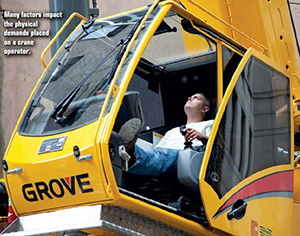Employers in best position to make determination
Fairfax, VA, November 18, 2019—The National Commission for the Certification of Crane Operators (NCCCO) has announced plans to remove the eligibility requirement for a physical (medical) evaluation for candidates for its certification exams. The change is effective January 1, 2020, and applies to all NCCCO operator certifications. NCCCO written and practical exam requirements are unaffected by this change.
The decision was taken, according to NCCCO CEO, Thom Sicklesteel, because the physical demands placed on a certified crane operator change according to such factors as the type and configuration of the crane and the environment it is working in, facts known only to the employer rather than the certification body.
“This is not in any way to minimize the importance of ensuring an operator is physically qualified, since physical examinations are a critical part of qualifying an operator,” said NCCCO CEO, Thom Sicklesteel, “But they do not align with the certification component.” Certifications are based on crane type, he said, whereas physical requirements are based on the specific crane to be operated and can be materially different for cranes even within the same crane type.
 “Jobs where the cranes are moving to multiple positions or that have higher cyclical work are typically more demanding,” Sicklesteel said. “Employers are required to qualify their crane operators by determining whether they are able to operate the specific crane they will work on, perform the type of work they will be assigned, and address any accommodations that may or may not be provided.” Certification bodies simply cannot know this information and so are not in a position to determine whether or not an operator is physically qualified.
“Jobs where the cranes are moving to multiple positions or that have higher cyclical work are typically more demanding,” Sicklesteel said. “Employers are required to qualify their crane operators by determining whether they are able to operate the specific crane they will work on, perform the type of work they will be assigned, and address any accommodations that may or may not be provided.” Certification bodies simply cannot know this information and so are not in a position to determine whether or not an operator is physically qualified.
Beyond the applicability of the physical qualification, Sicklesteel notes that the ASME B30.5 standard requires physical examinations to be done more frequently than the established recertification schedules. Lastly, and perhaps most importantly, due to privacy and legal concerns, physical qualifications are not portable between employers.
“It is NCCCO’s view that only employers are in a position to determine an individual’s specific capabilities,” Sicklesteel said. “Now that OSHA requires employers to conduct evaluations of all of their operators in the context of the equipment they will use and the work they will be doing, it seems only appropriate that it should be the employer who can also best make the determination of each operator’s physical abilities.”
The role of certification is to demonstrate a baseline level of knowledge and skill necessary to operate equipment safely, as well as the ability to recognize and avert risks associated with the operation. OSHA requires that the certification-issuing entity (e.g., NCCCO) be accredited by a nationally recognized accrediting agency (ANSI or NCCA) so as to be sure that industry-recognized criteria for written testing materials, practical examinations, test administration, grading, facilities/equipment, and personnel have been met.
Also per the OSHA Rule, the employer’s evaluation must take into account the size and configuration of the crane the operator plans to operate, including (but not limited to) the crane’s lifting capacity, boom length, any attachments (such as a luffing jib), and counterweight set-up, which are factors that are not relevant to the operator’s certification. Once the operator has been evaluated on a specific size and configuration of crane, that operator may operate other equipment that does not require substantially different skills, knowledge, or ability to recognize and avert risk to operate.
“The clarity that OSHA brought regarding employers’ evaluations is critical to a safer lifting industry,” said Sicklesteel. “NCCCO looks forward to continue working with the industry to navigate the changes and provide guidance related to credentialing for personnel in and around load handling equipment.”